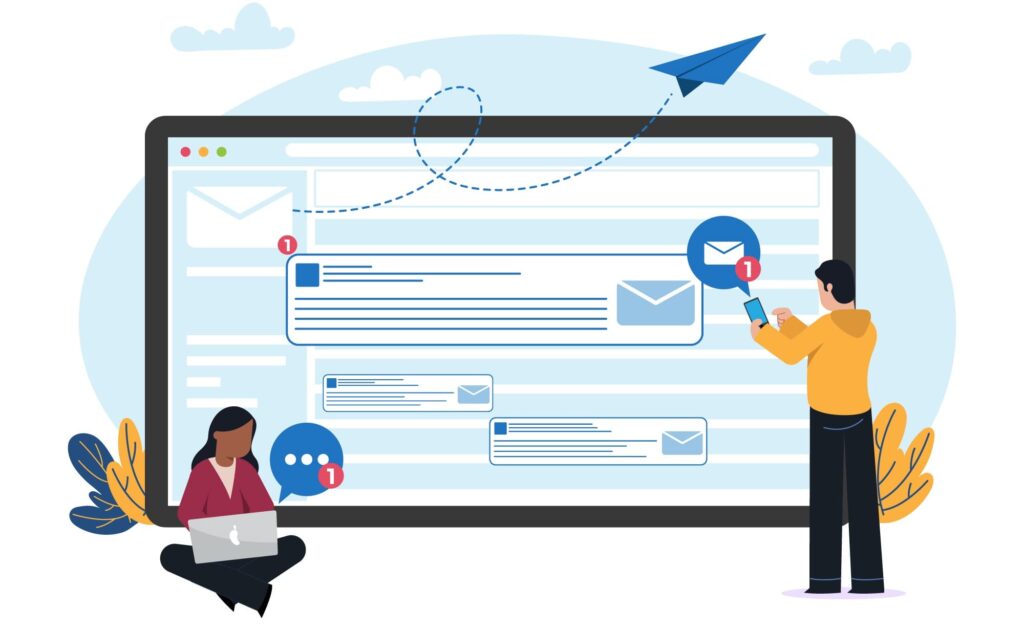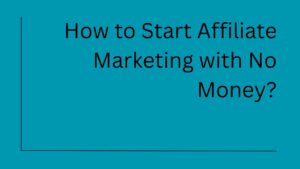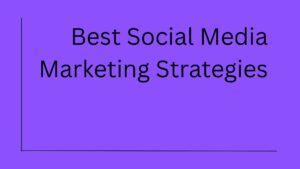Email marketing has emerged as one of the most effective ways of digital marketing to communicate with your audience, boost sales, and build lasting relationships with customers. And one of the most time-tested and effective methods is email marketing. If you’re just starting to explore this avenue or you’re considering how to incorporate email marketing into your business strategy, you’re in the right place. Whether you’re a small business owner or managing a large enterprise, email marketing provides a cost-effective and personalized way to reach people directly in their inboxes.
But what exactly is email marketing, and how can it benefit your business?
Let’s break it down in this beginner-friendly guide.
Email Marketing – The Simple Way to Market
To put simply, email marketing refers to using email as a way to communicate with your audience. This could be potential customers, current customers, or even previous customers who have shown interest in your brand. The goal of these emails is to build relationships, nurture trust, and ultimately increase sales.
Email marketing isn’t just about sending random emails to a list of people; it’s a targeted approach. The messages are carefully crafted to provide value to the recipient, whether through updates on new products, special offers, tips, newsletters, or other engaging content. The beauty of email marketing lies in its versatility — you can send emails to let people know about sales, announce new products, share valuable content, or even update them on company news.
The content of these emails can vary widely, including:
- Newsletters: Regular updates sharing news, tips, or insights about your industry or company.
- Promotional Emails: Announcements about sales, discounts, or exclusive offers.
- Product Launch Announcements: Introducing new products or services.
- Event Invitations: Inviting subscribers to webinars, workshops, or other events.
- Helpful Tips and Guides: Providing value through how-to guides, expert advice, or tutorials.
Through email marketing, you can keep your audience in the loop, reminding them about your business when they need your services or products. Essentially, it’s a way to remain top of mind and continuously nurture the relationship with your subscribers, making them more likely to choose your business when they’re ready to make a purchase.
Email Marketing Statistics – The Proven Numbers
Understanding the power of email marketing is crucial to making informed decisions about your campaigns. Here are some recent email marketing statistics that highlight its effectiveness and help guide your strategy:
- Email marketing drives a high ROI: For every $1 spent on email marketing, businesses earn an average of $42 in return (Source: Campaign Monitor).
- Mobile matters: 46% of all email opens happen on mobile devices, so it’s essential to optimize your emails for mobile users (Source: Litmus).
- Segmentation increases engagement: Marketers who use segmented campaigns note a 760% increase in revenue (Source: Mailchimp).
- Personalization boosts performance: Emails that are personalized see 6x higher transaction rates and 29% higher open rates (Source: Experian).
- Automation saves time: Automated email campaigns account for 21% of total email marketing revenue (Source: Omnisend).
These stats prove that email marketing remains one of the most effective tools for building relationships, boosting sales, and driving business growth.
The Key Components of Email Marketing
To fully understand how email marketing works, it’s important to break it down into its core components. Email marketing involves several moving parts that work together to create effective campaigns. Let’s take a closer look at some of these key elements:
1. Building a Targeted Email List
Email marketing begins with one crucial first step: building a targeted email list. You can’t market to an audience if you don’t know who they are. Building this list often starts with gaining permission from potential customers to send them emails. This is typically done through forms on your website, social media promotions, or incentives like discounts or freebies in exchange for email sign-ups.
It’s essential to ensure that the people on your list are genuinely interested in hearing from you. This is what makes a targeted email list so valuable. You don’t want to waste time or money sending emails to people who aren’t likely to engage with your business. Instead, focus on attracting subscribers who are interested in your products, services, or content. Over time, you’ll build a list of highly engaged recipients who will look forward to your emails.
2. Crafting Engaging Content
Once you’ve got your email list, it’s time to focus on creating engaging content. The key here is to provide value to your subscribers. Whether it’s educational content, promotions, or personalized recommendations, your goal should be to meet the needs and interests of your audience.
For example, if you’re a clothing retailer, you might send emails with new arrivals, sales, and styling tips. If you’re a software company, you might send tips on how to use your product more effectively, case studies, or even educational webinars. The idea is to provide something that your audience will find useful or interesting, so they’re more likely to engage with your emails and continue opening them.
3. Personalization
One of the greatest benefits of email marketing is the ability to personalize content. Personalization can come in many forms: addressing the recipient by name, offering personalized recommendations based on past purchases, or even sending birthday emails with a special discount. When your emails feel personalized and tailored to the individual, they’re much more likely to be opened, read, and acted upon.
The key to effective personalization is to gather and utilize data about your subscribers. This could include information about their past interactions with your brand, purchase history, location, and more. The more you know about your audience, the better you can customize your messages to meet their specific needs.
4. Consistency is Key
To see success with email marketing, you must be consistent. This doesn’t mean spamming your subscribers’ inboxes every day with irrelevant content, but rather sending regular, well-thought-out messages that add value. A good rule of thumb is to send emails at a frequency that doesn’t overwhelm your audience but keeps you top of mind. For example, you might send a weekly newsletter or monthly product updates.
Additionally, staying consistent in terms of quality is also important. Every email should provide something of value — whether it’s a helpful tip, an exclusive offer, or relevant news about your business. This consistent value is what keeps your audience engaged and eager to open your next email.
5. Analyzing and Improving Your Campaigns
One of the greatest advantages of email marketing is the ability to track and measure your campaigns. Most email marketing platforms provide detailed analytics that allow you to monitor how well your emails are performing. You can track metrics like open rates, click-through rates, conversion rates, and more.
By analyzing these metrics, you can gain insight into what’s working and what’s not. Are your subject lines compelling enough? Is your content resonating with your audience? Are people clicking on your links? By reviewing this data and making adjustments based on it, you can continually improve your campaigns and increase your ROI over time.
Why is Email Marketing Important?
Email marketing isn’t just about sending out messages to a list of people. It’s about building relationships, nurturing trust, and creating meaningful connections with your audience. Here’s why email marketing is a game-changer for businesses:
1. Direct Communication
Unlike social media, where algorithms determine who sees your posts, email marketing allows you to communicate directly with your subscribers. When someone joins your list, they’re giving you permission to reach them in their inbox. This means your message has a better chance of being seen, and you’re able to bypass all the noise on social platforms. Whether it’s important updates, new offers, or personal messages, emails give you a direct line to your audience.
2. Cost-Effective
When compared to traditional marketing methods like TV ads, print media, or pay-per-click campaigns, email marketing is incredibly affordable. Even small businesses with tight budgets can use email to reach thousands of potential customers. Plus, many email marketing platforms offer scalable pricing plans, meaning you can start small and increase your investment as your business grows. This cost-efficiency makes email marketing an attractive choice for businesses of all sizes.
3. Personalization
One of the most powerful aspects of email marketing is the ability to personalize your messages. With the right segmentation, you can send tailored content to specific groups of people based on their behaviors, preferences, or past purchases. For example, if a subscriber recently bought a product from your online store, you can send them related recommendations or special offers to keep them engaged. Personalization helps your emails stand out and makes your subscribers feel valued.
4. Measurable Results
Email marketing offers an advantage that many other marketing strategies can’t: measurable results. Most email marketing platforms provide detailed analytics that lets you track important metrics such as open rates, click-through rates, and conversions. By analyzing this data, you can see what’s working, and what isn’t, and fine-tune your approach for better outcomes. Whether adjusting subject lines or changing call-to-action buttons, data-driven decisions help you optimize your email strategy.
5. High ROI
Email marketing is consistently shown to deliver a high return on investment (ROI). According to studies, for every dollar spent on email marketing, businesses can expect a return of $36 or more. This incredible ROI makes email marketing one of the most cost-effective ways to drive sales, build relationships, and grow your brand.
How Does Email Marketing Work?
Effective email marketing involves more than just hitting “send.” Here are the essential steps:
1. Building an Email List
Start by gathering a list of subscribers who are genuinely interested in your business. This can be done through:
- Sign-up forms on your website
- Offering free resources like eBooks or templates in exchange for an email address
- Running contests or giveaways
2. Choosing an Email Marketing Platform
Platforms like Mailchimp, Constant Contact, and HubSpot make it easy to manage your email list, design emails, and track performance. Choose one that fits your business needs and budget.
3. Crafting Engaging Emails
The content of your emails should be valuable, relevant, and engaging. Use compelling subject lines, clear calls-to-action (CTAs), and visually appealing designs to capture attention.
4. Segmentation and Personalization
Divide your email list into segments based on factors like location, purchase history, or engagement levels. This allows you to send targeted messages that resonate with each group.
5. Monitoring and Optimization
Regularly review your email performance metrics. Are people opening your emails? Are they clicking on links? Use this data to tweak your strategy and improve future campaigns.
The Benefits of Email Marketing
Email marketing doesn’t just deliver measurable results—it offers a wealth of benefits that make it a crucial tool for any business. Here’s why it’s so valuable:
1. Stronger Customer Relationships
Consistent, relevant communication with your subscribers helps foster trust and loyalty over time. By keeping your audience informed, offering them value, and engaging them with personalized messages, you build a relationship that goes beyond just transactional. A loyal customer is more likely to return for repeat purchases and recommend your business to others.
2. Increased Sales
Email marketing is an excellent way to promote products, announce special offers, and drive sales. By sending timely offers or exclusive deals to your email list, you create a sense of urgency and encourage immediate purchases. You can also use email to upsell or cross-sell related products based on what your customers have already bought, increasing your revenue per customer.
3. Brand Awareness
Regular email communication keeps your brand at the forefront of your subscribers’ minds. Even if they don’t engage with every email, consistent messaging keeps your brand in their inbox, reinforcing your presence and what you stand for. Over time, this repeated exposure helps establish brand recognition and trust.
4. Customer Retention
Email marketing is a fantastic way to re-engage inactive customers. Whether they’ve abandoned their shopping cart or haven’t interacted with your brand in a while, email campaigns can be designed to bring them back. A well-timed reminder, special offer, or personalized message can reignite interest and encourage them to make a purchase.
5. Automation Capabilities
One of the biggest advantages of email marketing is automation. Once you’ve set up automated workflows, you can nurture leads and customers without lifting a finger. For example, welcome emails, cart abandonment reminders, birthday greetings, and post-purchase follow-ups can all be set up to trigger automatically based on customer actions. This saves time, enhances the customer experience, and helps increase conversions.
Challenges of Email Marketing (and How to Overcome Them)
Email marketing is a powerful tool, but like any strategy, it comes with its challenges. To make the most of it, you need to be prepared to handle potential obstacles that could hinder your success. Below, we’ve outlined some common challenges and practical tips on how to overcome them:
1. Low Open Rates
One of the most frustrating challenges in email marketing is when your emails aren’t getting opened. Low open rates can mean that your audience is not engaging with your content, which can significantly reduce the effectiveness of your campaigns.
How to Overcome It:
- Use Compelling Subject Lines: Your subject line is the first thing your subscribers see, so it needs to grab their attention. Keep it short, clear, and intriguing. Experiment with questions, personalization, or urgency to spark curiosity.
- Send Emails at Optimal Times: Timing is crucial. Test different sending times to see when your audience is most likely to open and engage with your emails. For example, many studies suggest sending emails in the early morning or around lunchtime during weekdays tends to yield better results.
- Segment Your Audience for Relevancy: Not all your subscribers have the same needs. By segmenting your list based on factors like purchase behavior, interests, or location, you can send more relevant, personalized content that resonates with each group, improving open rates.
2. Spam Complaints
Spam complaints can damage your reputation and decrease deliverability. If subscribers feel your emails are unwanted or irrelevant, they may mark them as spam, which can hurt future campaigns.
How to Overcome It:
- Ensure Subscribers Have Opted In: Only send emails to people who have willingly subscribed to your list. A double opt-in process can help confirm that the recipient genuinely wants to receive your emails.
- Avoid Overly Promotional Language: If every email you send feels like a hard-sell, subscribers may get annoyed and unsubscribe or report your emails as spam. Make sure to balance promotional content with valuable, engaging material that provides useful information or entertainment.
- Provide an Easy-to-Find Unsubscribe Option: If a subscriber no longer wants to receive emails, make it easy for them to unsubscribe. It’s not only a best practice but also a legal requirement under laws like GDPR and CAN-SPAM.
3. Email Fatigue
Subscribers can experience email fatigue if they feel overwhelmed by receiving too many emails, especially if they don’t find them valuable. When this happens, people are more likely to unsubscribe or ignore future messages.
How to Overcome It:
- Avoid Overloading Subscribers with Too Many Emails: Don’t bombard your subscribers with constant emails. Find the right balance in frequency to stay top of mind without being overbearing. Depending on your business, sending one email per week or biweekly may be sufficient.
- Focus on Quality Over Quantity: It’s better to send fewer, high-quality emails than a large volume of less valuable ones. Make sure each email provides something useful, whether it’s educational content, exclusive offers, or important updates.
4. Maintaining Engagement
Keeping your subscribers engaged over time can be tricky. People may stop opening your emails if they feel like the content is repetitive or no longer relevant to them.
How to Overcome It:
- Deliver Valuable Content Consistently: Keep your content fresh and useful by regularly providing value. Whether it’s tips, insights, or exclusive deals, make sure your emails offer something that your subscribers can’t get elsewhere.
- Experiment with Different Formats: Change up your content by incorporating various formats such as videos, infographics, polls, or quizzes. Engaging formats can make your emails stand out in crowded inboxes and keep your audience excited to see what’s next.
Why Email Marketing is a Good Investment?
Email marketing is often considered one of the most cost-effective forms of marketing. Unlike traditional advertising methods, it doesn’t require a large budget to get started. All you need is an email list, some creative content, and an email service provider (ESP) to send your emails.
However, just because it’s affordable doesn’t mean it’s a “get-rich-quick” strategy. Like any marketing method, email marketing requires time and effort to see significant results. Building a solid email list takes time, and creating engaging, valuable content for your audience doesn’t happen overnight. But when done right, email marketing can provide a substantial return on investment (ROI).
The real power of email marketing lies in its ability to nurture relationships over time. You won’t see an instant influx of sales from sending one email — but by consistently staying in touch with your subscribers, offering them valuable content, and gradually building trust, you’ll eventually see your efforts pay off in the form of increased sales and customer loyalty.
Tips for Getting Started with Email Marketing
If you’re new to email marketing, it can feel a bit overwhelming at first. But don’t worry! Here are some simple tips to help you get started:
- Choose the Right Email Marketing Platform: There are several email service providers out there, such as MailChimp, Constant Contact, and ConvertKit. Research the different options and choose the one that best fits your business needs.
- Segment Your Audience: Not all of your subscribers are the same. Segmenting your email list into groups (based on behavior, location, etc.) allows you to send more personalized and relevant content.
- Test Your Emails: Before sending your emails to your entire list, try testing them with a smaller group. This can help you identify issues and improve the effectiveness of your messages.
- Focus on the Subject Line: The subject line is the first thing people see when they receive your email, so make sure it’s compelling and enticing enough to encourage them to open it.
- Include a Clear Call to Action (CTA): Every email should have a clear CTA that tells the reader what you want them to do next—whether that’s making a purchase, signing up for an event, or downloading a resource.
Conclusion
Email marketing is an incredibly effective tool for building relationships with your audience, increasing brand awareness, and driving sales. It’s a strategy that requires patience and consistency but offers impressive long-term benefits when done correctly. By focusing on delivering valuable content to a targeted audience, personalizing your messages, and analyzing your results, you can turn email marketing into a powerful asset for your business.
Remember, it’s all about building trust and staying engaged with your audience. When you invest in email marketing and nurture those relationships over time, you’ll create a loyal customer base and see your business grow.
Now, it’s your turn to get started. Happy emailing!
Email Marketing FAQs
1. How do I build an email list for my business?
Offer incentives like discounts or free resources to encourage sign-ups on your website, social media, and checkout pages.
2. How often should I send marketing emails?
Send emails once a week or month, adjusting based on your business type and audience engagement.
3. How can I measure my email marketing success?
Track open rates, click-through rates, and conversion rates to gauge how well your emails are performing.
4. What content should I include in my emails?
Provide valuable content such as product updates, tips, promotions, or personalized offers to keep your audience engaged.
5. Is email marketing effective for small businesses?
Yes, email marketing is a cost-effective way for small businesses to engage with customers, drive sales, and build loyalty.






2 thoughts on “What is Email Marketing? A Simple Beginner’s Guide”
Thank you for writing a simple article on email marketing as a valued part of our digital success. Your commitment inspires many who look to start a blog every.
I’m just writing to make you understand what a beneficial experience many fellow readers would love to read. Many of which included what it’s like to possess awesome marketing topics to let many people really easily completely grasp specified, very confusing subject matter. You really did more than people expected. Many thanks for coming up with these necessary, informative, and easy tips on this topic; keep going.